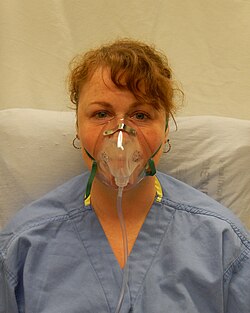
Back العلاج بالأكسجين Arabic मेडिकल इलाज में ऑक्सीजन Bihari Oxigenoteràpia Catalan Triniaeth ocsigen Welsh Sauerstofftherapie German Oxigenoterapia Spanish اکسیژندرمانی Persian Happihoito Finnish Oxygénothérapie normobare French טיפול בחמצן HE
 A person wearing a simple face mask | |
| Clinical data | |
|---|---|
| Other names | supplemental oxygen, enriched air |
| AHFS/Drugs.com | FDA Professional Drug Information |
| Routes of administration | inhaled |
| Drug class | medical gas |
| ATC code | |
| Identifiers | |
| CAS Number | |
| ChemSpider |
|
| UNII | |
| Chemical and physical data | |
| Formula | O2 |
Oxygen therapy, also referred to as supplemental oxygen, is the use of oxygen as medical treatment.[1] Supplemental oxygen can also refer to the use of oxygen enriched air at altitude. Acute indications for therapy include hypoxemia (low blood oxygen levels), carbon monoxide toxicity and cluster headache. It may also be prophylactically given to maintain blood oxygen levels during the induction of anesthesia.[2] Oxygen therapy is often useful in chronic hypoxemia caused by conditions such as severe COPD or cystic fibrosis.[3][1] Oxygen can be delivered via nasal cannula, face mask, or endotracheal intubation at normal atmospheric pressure, or in a hyperbaric chamber.[4][5] It can also be given through bypassing the airway, such as in ECMO therapy.
Oxygen is required for normal cellular metabolism.[6] However, excessively high concentrations can result in oxygen toxicity, leading to lung damage and respiratory failure.[2][7] Higher oxygen concentrations can also increase the risk of airway fires, particularly while smoking.[1] Oxygen therapy can also dry out the nasal mucosa without humidification.[1] In most conditions, an oxygen saturation of 94–96% is adequate, while in those at risk of carbon dioxide retention, saturations of 88–92% are preferred.[1][8] In cases of carbon monoxide toxicity or cardiac arrest, saturations should be as high as possible.[1][8] While air is typically 21% oxygen by volume, oxygen therapy can increase O2 content of air up to 100%.[7]
The medical use of oxygen first became common around 1917, and is the most common hospital treatment in the developed world.[1][9][10][11] It is currently on the World Health Organization's List of Essential Medicines.[11] Home oxygen can be provided either by oxygen tanks or oxygen concentrator.[1]
- ^ a b c d e f g h British national formulary : BNF 69 (69 ed.). British Medical Association. 2015. pp. 217–218, 302. ISBN 9780857111562.
- ^ a b World Health Organization (2009). Stuart MC, Kouimtzi M, Hill SR (eds.). WHO Model Formulary 2008. World Health Organization. p. 20. hdl:10665/44053. ISBN 9789241547659.
- ^ Jamison DT, Breman JG, Measham AR, Alleyne G, Claeson M, Evans DB, Jha P, Mills A, Musgrove P, eds. (2006). Disease Control Priorities in Developing Countries. World Bank Publications. p. 689. ISBN 9780821361801. Archived from the original on 2017-05-10.
- ^ Macintosh M, Moore T (1999). Caring for the Seriously Ill Patient 2E (2 ed.). CRC Press. p. 57. ISBN 9780340705827. Archived from the original on 2017-01-18.
- ^ Dart RC (2004). Medical Toxicology. Lippincott Williams & Wilkins. pp. 217–219. ISBN 9780781728454. Archived from the original on 2017-01-18.
- ^ Peate I, Wild K, Nair M (2014). Nursing Practice: Knowledge and Care. John Wiley & Sons. p. 572. ISBN 9781118481363. Archived from the original on 2017-01-18.
- ^ a b Martin L (1997). Scuba Diving Explained: Questions and Answers on Physiology and Medical Aspects of Scuba Diving. Lawrence Martin. p. H-1. ISBN 9780941332569. Archived from the original on 2017-01-18.
- ^ a b Chu DK, Kim LH, Young PJ, Zamiri N, Almenawer SA, Jaeschke R, et al. (April 2018). "Mortality and morbidity in acutely ill adults treated with liberal versus conservative oxygen therapy (IOTA): a systematic review and meta-analysis". Lancet. 391 (10131): 1693–1705. doi:10.1016/S0140-6736(18)30479-3. PMID 29726345. S2CID 19162595.
- ^ Agasti TK (2010). Textbook of Anesthesia for Postgraduates. JP Medical Ltd. p. 398. ISBN 9789380704944. Archived from the original on 2017-05-10.
- ^ Rushman GB, Davies NJ, Atkinson RS (1996). A Short History of Anaesthesia: The First 150 Years. Butterworth-Heinemann. p. 39. ISBN 9780750630665. Archived from the original on 2017-05-10.
- ^ a b Wyatt JP, Illingworth RN, Graham CA, Hogg K, Robertson C, Clancy M (2012). Oxford Handbook of Emergency Medicine. OUP Oxford. p. 95. ISBN 9780191016059. Archived from the original on 2017-01-18.